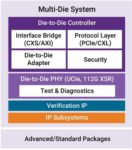Perforce recently hosted a webinar on “IP Lifecycle Management for Chiplet-Based SoCs”, presented by Simon Butler, the GM for the Methodics IPLM BU. The central theme was trust, for IPs as much as chiplets. How can an IP/chiplet consumer trust that what they receive has not been compromised somewhere in the value chain from initial… Read More
Interface IP in 2022: 22% YoY growth still data-centric driven
We have shown in the “Design IP Report” 2022 that the market share of the wired Interface IP category is a growing part of the total IP, and that this trend is confirmed year after year. The interface IP category has moved from 18% share in 2017 to 25% in 2022.
During the 2010-decade, smartphone was the strong driver for the IP industry,… Read More
CEO Interview: Anna Fontanelli of MZ Technologies
Anna has more than 25 years of expertise in managing complex R&D organizations and programs, giving birth to a number of innovative EDA technologies. She has pioneered the study and development of several generations of IC and package co-design environments and has held senior positions at leading semiconductor and EDA … Read More
WEBINAR: The Power of Formal Verification: From flops to billion-gate designs
Semiconductor industry is going through an unprecedented technological revolution with AI/ML, GPU, RISC-V, chiplets, automotive and 5G driving the hardware design innovation. The race to deliver high performance, optimizing power and area (PPA), while ensuring safety and security is truly on. It has never been a more exciting… Read More
Keynote Sneak Peek: Ansys CEO Ajei Gopal at Samsung SAFE Forum 2023
As one of the world’s leading chip foundries, Samsung occupies a vital position in the semiconductor value chain. The annual Samsung Advanced Foundry Ecosystem (SAFE™) Forum is a must-go event for semiconductor and electronic design automation (EDA) professionals. Ajei Gopal, President and CEO of Ansys, has the honor of delivering… Read More
Requirements for Multi-Die System Success
Chiplets continue to be a hot topic on SemiWiki, conferences, white papers, webinars and one of the most active chiplet enabling vendors we work with is Synopsys. Synopsys is the #1 EDA and #1 IP company so that makes complete sense.
As you may have read, I moderated a panel on Chiplets at the last SNUG which we continue to write about.
TSMC Doubles Down on Semiconductor Packaging!
Last week TSMC announced the opening of an advanced backend fab for the expansion of the TSMC 3DFabric System Integration Technology. It’s a significant announcement as the chip packaging arms race with Intel and Samsung is heating up.
Fab 6 is TSMC’s first all-in-one advanced packaging and testing fab which is part of the… Read More
WEBINAR: Revolutionizing Chip Design with 2.5D/3D-IC Design Technology
In the 3D-IC (Three-dimensional integrated circuit) chip design method, chiplets or wafers are stacked vertically on top of each other and are connected using Through Silicon Vias (TSVs) or hybrid bonding.
The 2.5D-IC design method places multiple chiplets alongside each other on a silicon interposer. Microbumps and interconnect… Read More
WEBINAR: UCIe PHY Modeling and Simulation with XMODEL
Join this webinar and see UCIe in action! This webinar presents the SystemVerilog models of a Universal Chiplet Interconnect Express (UCIe) interface, including both the analog circuits in the electrical layer and digital FSMs in the logical layer. The whole physical layer (PHY) model can be efficiently simulated in SystemVerilog,… Read More
Chiplet Interconnect Challenges and Standards
For decades now I’ve watched the incredible growth of SoCs in terms of die size, transistor count, frequency and complexity. Instead of placing all of the system complexity into a single, monolithic chip, there are now compelling reasons to use a multi-chip approach, like when the maximum die size limit is reached, or it’s… Read More











Website Developers May Have Most to Fear From AI